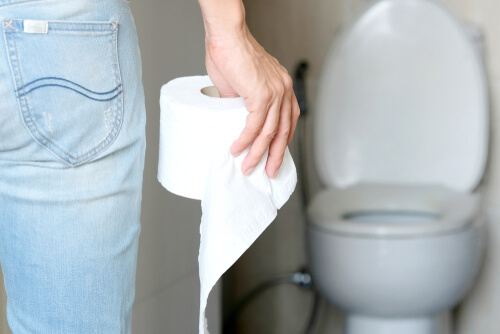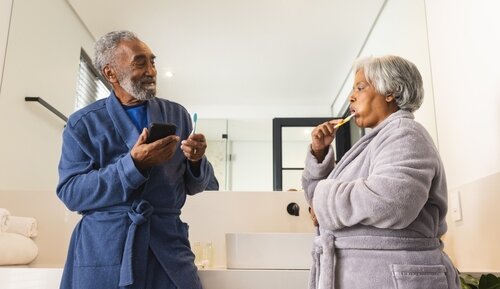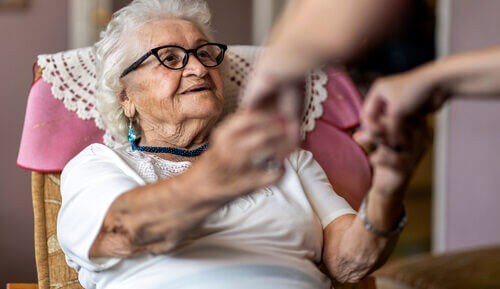
Page contents
Continence is the ability to control bladder and bowel movements. Many people lose this ability temporarily at any stage in their lives, while some people can become permanently incontinent due to old age, illness or disability. There are some treatments for incontinence and products to help manage it.
Struggling with continence, or being incontinent, can be a cause of embarrassment for people experiencing it but it is a common problem, particularly after childbirth, in old age and in people living with dementia.
Urinary incontinence is difficulty with controlling your bladder. Faecal incontinence is difficulty controlling your bowel movements.
Incontinence types by symptoms
People can experience incontinence very differently. Below are some of the types of incontinence according to how to they occur.
Urge incontinence
Also called an overactive bladder or bowel, this is when you feel the need to go to the toilet very frequently. The urge to go is usually very sudden and feels urgent. You may urinate or defecate involuntarily if you don’t act on the urge.
Passive incontinence
When you go to the toilet, you use muscles to do so. They contract to let your urine or faeces out. With passive incontinence, these muscles contract without your control and without any warning.
Stress incontinence
This is when incontinence is triggered by something sudden, like laughing, coughing, sneezing or screaming. Physical exertion or stress can also cause stress incontinence, particular if it puts pressure on the abdomen or is sudden, like jumping or tripping over.
Functional incontinence
This is when your bowel and bladder work normally, but another condition means you often don’t make it to the toilet or notice that you need to go. This could be anything from dementia to not being able to move quickly enough to get to the toilet in time.
Overflow incontinence
This is when the bladder doesn’t empty completely which can cause regular or constant leaking of urine. This is usually caused by something blocking the urethra, such as swollen prostate glands or a prolapse. Some people with overflow incontinence don’t feel the urge to urinate.
Mixed incontinence
People with mixed incontinence experience more than one of the above.
What causes incontinence?
Incontinence can have a wide range of causes, these include:
- Old age
- Dementia
- Childbirth
- Urinary tract infections (UTIs)
- Prostate enlargement
- Diarrhoea
- Constipation
- Irritable bowel syndrome (IBS)
- Poor diet
- Excessive alcohol
- Laxative abuse
Are there any treatments for incontinence?
Pelvic floor exercises
These exercises help strengthen your pelvic floor muscles, giving greater control when passing urine.
One exercise is to lie or the floor with your knees bent and your feet shoulder-width apart. Lift your pelvis up and squeeze the muscles as hard as you can, holding for several seconds. Repeat 10 – 15 times and perform the routine every day. You can do this sitting in a chair too, but don’t attempt the thrust in a chair.
As well as being a treatment for incontinence, pelvic floor exercises also strengthen the vagina and can help with erectile dysfunction.
Bladder training
This involves forcing yourself not to go to the toilet for a few minutes after you feel the need to. The idea is to train your bladder or bowel to hold its contents until you pass it in a controlled way. Your doctor can give you more guidance on this.
You can also train your bladder by allotting certain times that you go to the toilet, whether you feel the need to or not, and sticking to that schedule.
Surgery
Surgery can be an effective treatment for causes of incontinence, depending on the cause. Surgery can fix or improve prolapses, remove tumours or cysts blocking the urethra or rectum.
Other types of surgery to help with continence include:
- Fitting a catheter
- Nerve stimulation, which uses electrical currents to improve communication between the muscles you use to go to the toilet and your brain
- A sphincteroplasty, which repairs the sphincter muscle after childbirth or injury to improve faecal incontinence
- Colposuspension, which lifts the neck of the bladder
- Sling surgery, that fits a sling around parts of the bladder that need support
- Vaginal mesh, that puts a supportive mesh strip behind the urethra
- A pessary. Women suffering urinary incontinence due to a prolapsed uterus or bladder can be fitted with a pessary. This is fixed into the vagina and holds the dropped organ up so it doesn’t block the urethra
- An artificial urinary sphincter. A more common treatment for men, this stops wee leaving the bladder and travelling down the urethra. Instead, you have a pump fitted in your scrotum which you can use to control the sphincter and allow urine through it.
- An artificial anal sphincter. As with above, but it puts a controllable block between the rectum and anus.
Medication
Various medications can relax the muscles around the bladder, making it easier to pass urine. Oestrogen cream can also help women to revitalise the urethra.
Can I adapt my diet to manage incontinence?
Changing your diet can help you to manage incontinence.
Reducing your intake of fizzy drinks, caffeine, alcohol and artificial sweeteners can really help, while eating and drinking smaller amounts more frequently can make digestion more regular.
Getting the right amounts of fibre and protein in your diet, and staying hydrated, can significantly improve symptoms. Tracking your macronutrients can be helpful with this, and there are many smartphone apps, online tools and books that can help with this. Macronutrients include fibre, protein, carbohydrates, fat, water, vitamins and minerals.
A person’s required macronutrients vary according to their age, height and any medical conditions they have, such as diabetes. Your doctor can guide you on how to improve your diet to manage incontinence.
Maintaining a healthy weight can also help with treatment of incontinence.
What products can help me to manage incontinence?
There are plenty of products available that can help you manage incontinence in your day-to-day life.
Products you may find useful include:
- Absorbent pads. These can be small pads that look like sanitary towels (‘always’ do a line of these called ‘always discreet’ that look just like period pads). Or, you can get full pull-up incontinence pants, some of which are designed to look like normal knickers. There are designs available for men and women, and you can buy them in chemists and supermarkets. It is sometimes possible to get them on the NHS, but you’ll have to collect them each month from a healthcare facility.
- A commode. If you struggle to get to the toilet in time at night, you could consider having a commode in your bedroom. It’s much like a chamber pot but sits on a frame with a seat. You can empty it into the toilet and clean it each morning, which only takes a few minutes.
- Washable bed pads and seat pads to protect chairs in your home or car
- Incontinence wipes
- Incontinence swimwear
Other tips for managing incontinence
Further strategies include:
- Wear loose-fitting clothes with elastic or zips rather than buttons, so that you can get them off quickly when you need to go.
- Carry a change of underwear, wipes and a plastic bag with you in case of accidents
- Plan ahead when going somewhere new to find out where the toilets are
- Regular exercise can aid digestion, with walking being particularly effective.

